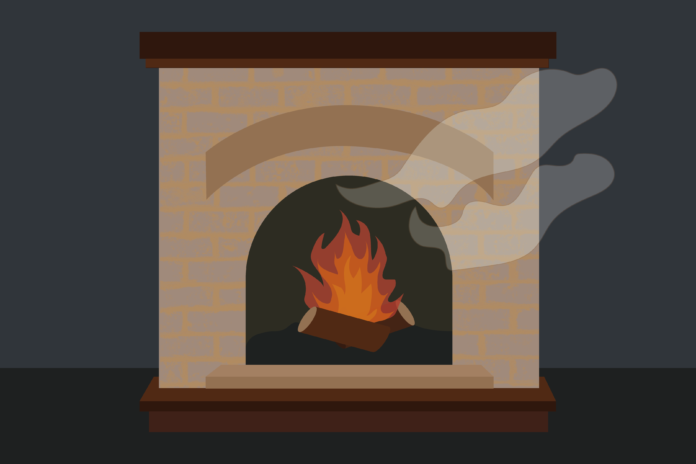Local air quality management programs maintain low levels of fine particulate matter and ozone in the atmosphere with the help of forecasting
By LEVI GOLDSTEIN — city@theaggie.org
From November through February, Yolo-Solano Air Quality Management District (AQMD) issues a Don’t Light Tonight advisory, which asks residents of the district to not light wood-burning stoves or fireplaces on days when air pollution is expected to be high.
Yolo-Solano AQMD was jointly established in 1971 by the Yolo County Board of Supervisors and the Solano County Board of Supervisors, according to its website. The District includes all of Yolo County and part of Solano County, including Rio Vista, Dixon and Vacaville.
Local air quality management districts, of which there are 35 in California, operate below state-level air quality management, or the California Air Resources Board, according to Executive Director of Yolo-Solano AQMD Mat Ehrhardt.
“Air quality management districts […] are tasked with managing the oversight of implementation of the Clean Air Act at the local level as well as encouraging public outreach and involvement in protecting the air quality,” said Stephanie Holliday, the Yolo-Solano AQMD Administrative Analyst and Public Information Officer. “So our local mission here […] is basically to protect human health […] from the harmful effects of air pollution.”
Yolo-Solano AQMD partners with Sonoma Technology (STI), an environmental consulting firm. STI measures air pollution and performs air quality forecasting across the U.S., according to Chief Executive Officer Leo Chinkin. STI also helped develop AirNow.gov, a real-time air quality data site.
For Don’t Light Tonight, the District issues a warning in advance when, the next day, the Air Quality Index (AQI) will be above 78, or 25 micrograms of particulate matter per cubic meter, according to Ehrhardt.
“It’s a regular weather forecast, but then we’re applying what’s going to happen with the pollutants over a region,” said Jeff Beamish, a meteorologist at STI. “Basically we’re trying to find those pollutant sources, figure out where they’re going to be heading, how the weather is going to impact them and come up with an AQI forecast.”
AQI was developed by the U.S. Environmental Protection Agency (EPA) as a unitless index for particulate matter and ozone levels in the atmosphere, according to Chinkin.
“The AQI is designed by the EPA to be a short-term indicator to help the public make decisions about protecting their health,” Chinkin said.
The forecasts are based on an average hourly concentration. Each pollutant has its own AQI value; whichever value is highest is broadcasted. According to Beamish, ozone is usually higher in the summer, so particulate matter is the primary concern in winter.
“The amount of sunlight that is available during the day plays a very key role in the ozone developments,” Beamish said. “It’s typically why ozone is the main driver behind pollution during the summer months versus the winter, because the days are longer during the summer.”
During winter, cold temperatures can trap air particles closer to the ground, according to a press release published by the Yolo-Solano AQMD on Nov. 1, 2021.
Wood smoke contains fine particulate matter (PM 2.5), which is especially unsafe because it can travel more easily to the heart and lungs than particles of larger size. A high concentration of fine particles in the air can cause respiratory problems for children, the elderly and those with existing health conditions. Long exposure over time can lead to even more health problems, Beamish said.
Don’t Light Tonight is meant to maintain lower levels of particulate matter in the air to reduce the health risks for residents in the district.
“The impact of people not burning can keep AQI values maybe five to 10 AQI lower than what we’re forecasting,” Beamish said. “The action of not burning […] when we issue the Don’t Light Tonight advisory for Yolo and Solano counties has a huge, huge impact.”
Holliday also believes it’s a matter of courtesy.
“By encouraging residents to not use their fireplaces, you can have a very real impact on your neighborhood, so not just yourself but the people that live around you,” Holliday said.
To know when a Don’t Light Tonight warning has been issued, residents can sign up for EnviroFlash, the District’s free email and text notification service. They can also check the District’s social media, visit their website or call (530) 757-3787 to listen to a recorded message.
STI also forecasts for Sacramento Metropolitan Air Quality Management District’s Check Before You Burn program, which also runs from November through February, according to Beamish. Unlike Don’t Light Tonight, Check Before You Burn prohibits wood burning by law when a warning for high AQI has been issued.
Yolo-Solano AQMD also has a summer program, Spare The Air, where from May through October, residents are advised not to use their automobiles on days when smog levels are high.
“Gasoline vapors combining with sunlight can increase ozone levels during the summer months,” Beamish said. “Instead of fueling your tank at 4 p.m., doing it at 9 p.m. can really make all the difference in the world.”
Beamish believes that these local programs demonstrate that the actions of individuals really can help better the environment.
“The main takeaway from it is people can make a difference in air quality in their region just by a simple act of not lighting wood on fire,” Beamish said.
Written by: Levi Goldstein — city@theaggie.org




